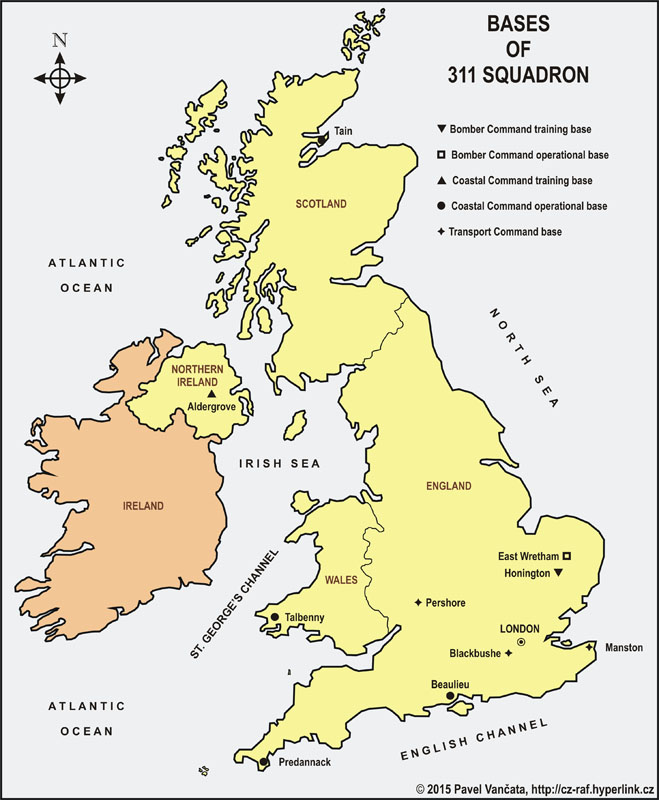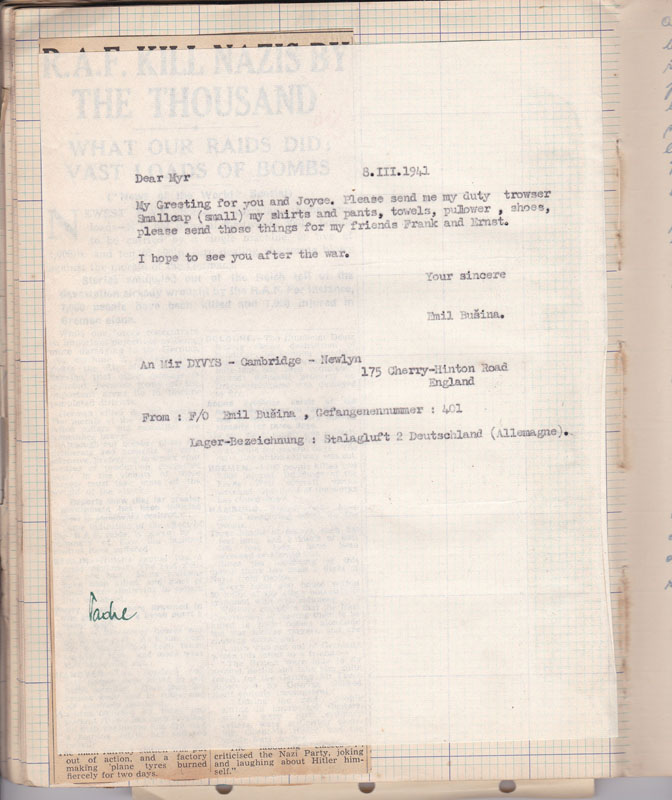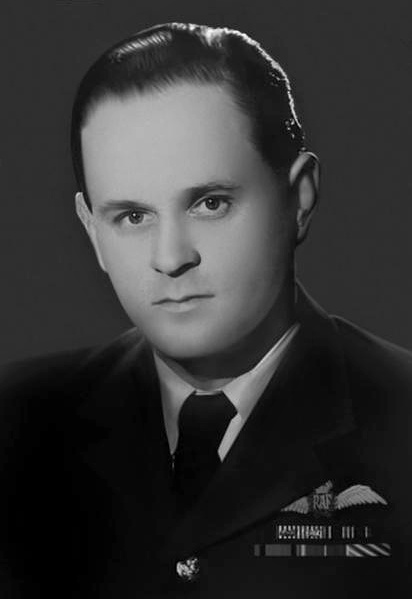311 (Czechoslovak) Squadron
Code Letters: KX, PP
Date and place of establishment: 29th July 1940/29.
Date of Disband: 15th February 1946, Plzeň, Havlíčkův Brod, Czechoslovakia
 Motto in English means Never regard their numbers.
Motto in English means Never regard their numbers.
After completion of operational services the 311 (Czechoslovak) Squadron provided transportation from the UK to Czechoslovakia. During this time, it flew from the bases in Manston, Pershore and Blackbush.

Squadron Commanders of 311 (Czechoslovak) Squadron
W/Cdr Karel TOMAN − MAREŠ, DFC, W/Cdr John GRIFFITHS, DFC (British/britský spoluvelitel), W/Cdr William S. P. SIMMONDS (British/britský spoluvelitel), W/Cdr Josef SCHEJBAL, W/Cdr Josef OCELKA, DFC, W/Cdr Josef ŠNAJDR, DFC, W/Cdr Jindřich BREICETL, DFC, W/Cdr Vladimír NEDVĚD, MBE, DFC, W/Cdr Josef ŠEJBL, DFC,
W/Cdr Jan KOSTOHRYZ, DSO
311 (Czechoslovak) Squadron used Wellington and Liberator planes.
Its first sortie took place on 10th September 1940, and the target was the marshalling yard in Brussels.
Squdron was posted from Bomber Command to Coastal Command beause high losses and no backups in year 1942.
During service crews of 311 (Czechoslovak) Squadron carried out 3,140 sorties lasting nearly 27,000 operational hours, while a total of 246 flying personnel were killed or went missing. During its existence the air gunners shot down eight planes with certainty, seven probably, and damaged fifteen. Its crews sank two submarines with certainty, three with high probability and four were damaged enough that they likely sank.
The most frequent target of the 311 (Czechoslovak) Squadron under the Bomber Command were Bremen and Cologne, which this squadron attacked seventeen times.
The squadron’s greatest success was the sinking of the blockade runner Alsterufer, which transported over 300 tons of rare tungsten from Japan to Germany. Airmen of this squadron successfully attacked the blockade runner Himalaya and damaged it and the cruiser Prinz Eugen which was probably hit.
The squadron member with the most flight hours in the Bomber Command was pilot W/Cdr Josef Ocelka, DFC, who flew forty-four operational flights totalling a time of 224.5 hours.
The squadron member with the most flight hours in the Coastal Command was wireless operator F/Lt Miroslav Vild, DFC, who flew 102 operational missions in the Coastal Command, with a total time of 1,178 hours and 32 minutes (and additionally, four operational flights totalling 18 hours and 32 minutes in the Bomber Command).
The personnel of the 311 (Czechoslovak) Squadron was then assigned to the air transport Regiment and the 6th Air Division, which consisted of Aviation Regiment 24, redeployed to the Plzeň – Bory airbase, and as of 3rd March 1948 bearing the honorable name “Biskajský” and Aviation Regiment 25, relocated to the airbase in Havlíčkův Brod, and as of 3rd March 1948 bearing the honorable name “Atlantic”.
The 311 (Czechoslovak) Squadron also participated in the Fuller operation – an effort to prevent the escape of the German flotilla through the La Manche channel, Millenium (attacks by approximately 1,000 planes on a single target), Overlord (operation Cork) – protection of the La Manche channel against German submarines and it also attacked targets in Italy.
 Aerial view of the first base of the 311 (Czechoslovak) Squadron in Honington. Archive of Pavel Simet
Aerial view of the first base of the 311 (Czechoslovak) Squadron in Honington. Archive of Pavel Simet
 Record in the diary of the 311 (Czechoslovak) Bomber Squadron. Copy of a letter from navigator Emil BUŠINA from a prison camp. He became a prisoner of war after his plane accidentally landed at an occupied airport during his return from a raid on Boulogne. The radio operator in this crew was Arnošt VALENTA, the only Czechoslovak airman who did not return from captivity - he was murdered by the Gestapo. His profile is displayed in another section of this exhibition. I assume that the Ernst, for whom he is requesting clothing, is that Arnošt VALENTA. Frank could be František CIGOŠ, the pilot of BUŠINA’s aircraft. Archive of Petra Tonder.
Record in the diary of the 311 (Czechoslovak) Bomber Squadron. Copy of a letter from navigator Emil BUŠINA from a prison camp. He became a prisoner of war after his plane accidentally landed at an occupied airport during his return from a raid on Boulogne. The radio operator in this crew was Arnošt VALENTA, the only Czechoslovak airman who did not return from captivity - he was murdered by the Gestapo. His profile is displayed in another section of this exhibition. I assume that the Ernst, for whom he is requesting clothing, is that Arnošt VALENTA. Frank could be František CIGOŠ, the pilot of BUŠINA’s aircraft. Archive of Petra Tonder.
 East Wretham, second base of the 311 (Czechoslovak) Bomber Squadron. Year 1941. 1. VALACH Karel, 2. HORÁK Josef, 3. KONŠTACKÝ Vilém, 4.FILLER Josef, 5. ANDERLE Leo, 6. VNOUČEK Jindřich, 7. ČTVRTLÍK Miroslav, 8. BERNÁT Josef, 9. SLÁNSKÝ Vladimír, 10. BREITCETL Jindřich, 11. KIRCHSTEIN Alois, 12. KOŠEK Ludvík, 13. ROZUM Alois, 14. ŠTUDENT Václav, 15. KORDA Václav, 16. ZAPLETAL Milan, 17. NEDVĚD Vladimír, 18. JEDOUNEK Arnošt, 19. BEČVÁŘ Karel, 20. ŠNAJDR Josef, 21. PROCHÁZKA Bedřich, 22. RADINA František, 23. MACHÁLEK František, 24. FENCL František, 25. DOSTÁL Hugo? 26. DOKTOR Jaroslav, 27. DOUBRAVA Josef?, 28. JAKŠ Vilém. Archiv Tomáše Jambora. Archive of Tomáš Jambor
East Wretham, second base of the 311 (Czechoslovak) Bomber Squadron. Year 1941. 1. VALACH Karel, 2. HORÁK Josef, 3. KONŠTACKÝ Vilém, 4.FILLER Josef, 5. ANDERLE Leo, 6. VNOUČEK Jindřich, 7. ČTVRTLÍK Miroslav, 8. BERNÁT Josef, 9. SLÁNSKÝ Vladimír, 10. BREITCETL Jindřich, 11. KIRCHSTEIN Alois, 12. KOŠEK Ludvík, 13. ROZUM Alois, 14. ŠTUDENT Václav, 15. KORDA Václav, 16. ZAPLETAL Milan, 17. NEDVĚD Vladimír, 18. JEDOUNEK Arnošt, 19. BEČVÁŘ Karel, 20. ŠNAJDR Josef, 21. PROCHÁZKA Bedřich, 22. RADINA František, 23. MACHÁLEK František, 24. FENCL František, 25. DOSTÁL Hugo? 26. DOKTOR Jaroslav, 27. DOUBRAVA Josef?, 28. JAKŠ Vilém. Archiv Tomáše Jambora. Archive of Tomáš Jambor
 Record in the diary of the 311 (Czechoslovak) squadron. Handwritten note adds: “Another one on the German account!” He calmly asks friends – but that calm is hard, promising a hard and relentless settling of accounts. In reality the Wellington KX–T was shot down over Zuider See. Only Emanuel NOVOTNÝ and Augustin ŠESTÁK, managed to jump out, and they ended up captured. The others were buried at the main cemetery in Oosterwolde, Oldebroek. Archive of Petra Tonder.
Record in the diary of the 311 (Czechoslovak) squadron. Handwritten note adds: “Another one on the German account!” He calmly asks friends – but that calm is hard, promising a hard and relentless settling of accounts. In reality the Wellington KX–T was shot down over Zuider See. Only Emanuel NOVOTNÝ and Augustin ŠESTÁK, managed to jump out, and they ended up captured. The others were buried at the main cemetery in Oosterwolde, Oldebroek. Archive of Petra Tonder.
 Squadron armourers. Archive of Tomáš Jambor.
Squadron armourers. Archive of Tomáš Jambor.
 East Wretham, 16th October 1940. L–R: Sgts Augustin ŠESTÁK, Jan PLZÁK, Karel KLIMT (KIA, 16th October 1940), Karel VALACH (KIA 23rd June 1941). Possibly last photo of Sgt KLIMT. Archive of Jaroslava Rozumová
East Wretham, 16th October 1940. L–R: Sgts Augustin ŠESTÁK, Jan PLZÁK, Karel KLIMT (KIA, 16th October 1940), Karel VALACH (KIA 23rd June 1941). Possibly last photo of Sgt KLIMT. Archive of Jaroslava Rozumová
 Vladimír NEDVĚD, youngest commander of the 311 (Czechoslovak) Bomber Squadron. For his attempt to save his comrade in arms, he received The Most Excellent Order of the British Empire - MBE. This is how he recalls the crash of his airplane on the night between the 16th and 17th of 1940 after the start of an attack on Mannheim: "... I escaped from the fiery cage of the shattered plane ... I remembered Jarda TOUL in the rear ... the rear turret was turned to the side, but it was closed ... I found Jarda TOUL curled behind the guns ... “Jarda, you´ve got to get out fast, the whole machine is on fire” ... I tried to lift him. It wasn’t possible ... the entire front of the plane was a single flame... only about four meters remained. Terrified by this distance, which was was slowly decreasing, and aware of what awaited Jarda ... I once again grabbed hold of his jumpsuit ... he could not be allowed to burn to death ... we jointly lifted his body ... but it didn’t go any further. The fire kept coming closer and suddenly - there was a thundering explosion. Only now did I realize that there were bombs in the plane...the fire was getting dangerously close...Jarda had both legs stuck under the seat and the entire weight of the tail was lying on them. I realized that I couldn’t lift the entire back end....I knew what awaited him...burning alive. There was a new loud explosion, the dazzling white flame of burning aluminum mingled with the tongues of flame of an oil bomb ... I leaned toward Jarda “I can’t get your legs free,” I said to him, …“Please, ...stay with me,” he said quietly. He was still fully conscious, not injured anywhere, only on his legs. I stayed with him at the turret. “I have a revolver in my pocket – shoot me”. Those were his last words to me. Then came the hardest decision of my life. What to do? …I searched for the weapon in his pockets, but couldn’t find it ... the third bomb exploded. The shock wave hit me...I flew off about five meters...” Jaromír TOUL was later took out, but died of burns.
Vladimír NEDVĚD, youngest commander of the 311 (Czechoslovak) Bomber Squadron. For his attempt to save his comrade in arms, he received The Most Excellent Order of the British Empire - MBE. This is how he recalls the crash of his airplane on the night between the 16th and 17th of 1940 after the start of an attack on Mannheim: "... I escaped from the fiery cage of the shattered plane ... I remembered Jarda TOUL in the rear ... the rear turret was turned to the side, but it was closed ... I found Jarda TOUL curled behind the guns ... “Jarda, you´ve got to get out fast, the whole machine is on fire” ... I tried to lift him. It wasn’t possible ... the entire front of the plane was a single flame... only about four meters remained. Terrified by this distance, which was was slowly decreasing, and aware of what awaited Jarda ... I once again grabbed hold of his jumpsuit ... he could not be allowed to burn to death ... we jointly lifted his body ... but it didn’t go any further. The fire kept coming closer and suddenly - there was a thundering explosion. Only now did I realize that there were bombs in the plane...the fire was getting dangerously close...Jarda had both legs stuck under the seat and the entire weight of the tail was lying on them. I realized that I couldn’t lift the entire back end....I knew what awaited him...burning alive. There was a new loud explosion, the dazzling white flame of burning aluminum mingled with the tongues of flame of an oil bomb ... I leaned toward Jarda “I can’t get your legs free,” I said to him, …“Please, ...stay with me,” he said quietly. He was still fully conscious, not injured anywhere, only on his legs. I stayed with him at the turret. “I have a revolver in my pocket – shoot me”. Those were his last words to me. Then came the hardest decision of my life. What to do? …I searched for the weapon in his pockets, but couldn’t find it ... the third bomb exploded. The shock wave hit me...I flew off about five meters...” Jaromír TOUL was later took out, but died of burns.
After the communist takeover, Vladimír NEDVĚD, MBE hijacked a plane of Československé aerolinie and flew abroad. He rejoined the RAF and served until 1955.
 After returning from a raid. Archive of Tomáš Jambor
After returning from a raid. Archive of Tomáš Jambor
foto#112
 Memorial to Czechoslovak Airmen, Tain. Archive of Tain & District Museum
Memorial to Czechoslovak Airmen, Tain. Archive of Tain & District Museum
 Eduard ŠIMON, air gunner, Charles PICKARD, liaison–officer for this squadron, Karel BEČVÁŘ, navigator, and Josef OCELKA, third commander of this squadron. Archive of Pavel Vančata
Eduard ŠIMON, air gunner, Charles PICKARD, liaison–officer for this squadron, Karel BEČVÁŘ, navigator, and Josef OCELKA, third commander of this squadron. Archive of Pavel Vančata